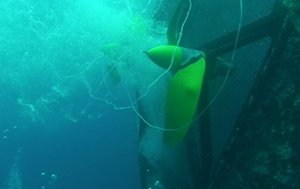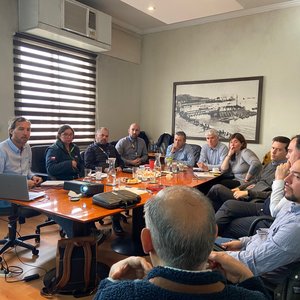Self-propelled Aquaculture Cage Debuts in Culebra
A boat towing a fish cage is business as usual on fish farms. But a cage towing a boat? That novel role reversal was on display recently in Culebra, Puerto Rico, as part of a project led by Cliff Goudey, director of MIT Sea Grant's Offshore Aquaculture Engineering Center (OAEC). Goudey conducted the tests at Snapperfarm, Inc., an offshore fish farm that has been growing cobia in submerged cages for five years. The spherical cage, developed by Ocean Farm Technologies, Inc. of Searsmont, Maine, was an Aquapod with a capacity of 3,250 m3.
The project is funded by NOAA’s Marine Aquaculture Program, aimed at demonstrating the technology needed to raise fish in the vast portions of the U.S. EEZ that are too deep for conventional anchored fish cages. By operating while submerged and in predictable ocean currents, mobile fish farms need only a modest means of positioning to stay within planned trajectories. There are many locations both in U.S. waters and around the world where oceanic currents and gyres offer useful frameworks for such mobile operations. Though futuristic compared to today’s near-shore fish farming practices, the concept avoids the user conflicts and compromised water quality of coastal waters. However, it introduces technical and logistic challenges, including the need for efficient self-propulsion.
In conventional protected-water fish farming, cages are routinely repositioned when their shallow sites are fallowed to control disease. Stout towboats haul the enormous cages to another site, and both the cage size and typical propulsive inefficiency of boats make such movements very energy-intensive events.
Goudey‘s different approach to moving cages exploits the inherent efficiency of large-diameter, slow-turning propellers. By placing propellers on a cage, Goudey frees it from the normal constraints of a boat. His system uses a pair of eight-foot diameter, electrically powered propellers, with 6.2-horsepower underwater motors. Through a two-stage reduction gear, the propellers turn 42 RPM at full speed. By fixing a pair of the units to the mid-depth of the 62-foot diameter Aquapod, in a horizontal line nine feet apart, Goudey was able to maneuver the cage like any twin-screw vessel.
The thrusters were installed on the Aquapod and a suitable amount of fixed buoyancy was added to balance their combined underwater weight of 800 pounds. The three-phase motors were powered through tethers to the surface and a diesel generator and a pair of variable-frequency motor controllers mounted on Snapperfarm’s small harvest boat, Market Size.
Goudey conducted initial system tests while the cage was in its normal bi-directional mooring. He then released the rear moorings, with a 1,500 hp tug standing by in case of a system failure. Next, the thruster system powered up against a half-knot flood tide until the forward moorings went slack and could be released. Testing of the world’s first self-propelled cage then began, with the objectives being twofold: 1) to measure the speed vs. power of the system, and 2) to determine the maneuverability of the cage using differential power to the two thrusters.
The weather did not cooperate on the day of these tests, with 25 knots of breeze over open-ocean to the east. In the 4- to 7-foot waves, the current meter gave poor results, but the full-speed movement through the water was estimated at between 0.5 to 0.6 knots. This was slightly higher than the predictions based on the thrust specifications and previous tow tests performed on the cage.
The maneuverability of the cage was found to be excellent even though the Aquapod has high drag while offering no directional stability and little momentum. The speed and heading control proved predictable and precise, essential for self-propulsion.
“These tests demonstrate that the concept of mobile cage operations is technically feasible,” explains Goudey. “The economic feasibility remains an open question, as only a very large-scale operation could support offshore mobile fish farming. However, the utility of cage self-propulsion extends well beyond the futuristic application of ocean-going aquaculture,” he continues.
The movement of cages during deployment, for relocation during fallowing, or for moving fish from the farm site to a harvest site is already a common procedure. Such transits would be simpler and use far less energy employing a high-efficiency, cage-mounted propulsion system. On such occasions the thrusters would be mounted on the cage, with their number and size dependent on the resistance of the cage, the distance to be moved, and the speed requirements due to anticipated tidal currents.
Besides the use of self-propulsion for routine cage movements, the thrusters have additional utility. Often, the limiting factor in cage stocking density is dissolved oxygen levels due to fish metabolism during slack water. The thrusters provide a ready opportunity to supplement water flow through the cage during those brief events, thereby allowing larger crops of fish.
All involved in the testing were impressed with the performance of the thrusters. Steve Page, CEO of Ocean Farm Technologies states, “My opinion of the thrusters is very high. I want to consider using them to help with future installations. There is also a growing demand for self-propelled harvest pens that may be a great market for this technology.”
Brian O’Hanlon, founder of Snapperfarm, comments, “I was incredibly impressed with the power and efficiency of the thrusters and Cliff’s ability to steer the cage. I see this technology having a broad range of applications in mariculture and other marine industries. This futuristic concept of farming the high seas just came one step closer to reality.”
With the technical feasibility proven, Goudey will be turning his attention to assessing the system’s economic viability, both as a tool for routine cage movements in offshore fish farming and in a business strategy involving mobile cages associated with specific routes in concert with predictable ocean currents or tidal gyres. This future work will involve the collaboration of ocean modelers and aquaculture business people.
MIT Sea Grant Videos - [Open Video Gallery]











